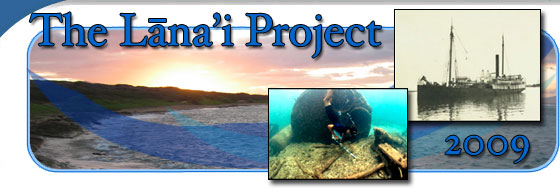Project Results
 |
|
The shoreline map, with geographic datum for reference. Click here for a larger map. (NOAA ONMS)
|
The main product of an in situ survey is the description and inventory of all of the major artifacts and features of the wreck site. The inventory often takes the form of a site plan or map. During the 2009 survey the divers produced two such site maps. One represents a broad area including the location of the shoreline, and the other depicts the main wreckage location in greater detail.
 |
|
The main site map, produced by baseline trilateration. Click here for a larger map. (NOAA ONMS)
|
The shoreline and main wreck maps, along with individual drawings of artifacts and all field measurements and notes, provide valuable information for interpreting maritime heritage resources. Additionally, photographs of the artifacts can help to fill in the blanks in the effort to identify the vessel. Survey results help us understand the history behind the resources, and add value to specific coastal and marine locations.
Wreck Site Description
 |
|
Divers were able to approach the boiler face during calms seas. One of two furnace doors, lined with fire brick. (J Coney/NOAA ONMS)
|
The wreck site lies in shallow water six to eight feet deep on a sand and rock bottom. Prevailing winds and waves come from the northeast. Two to four-foot wind waves and 15-25 knot winds were common during the survey. Wreck material extends some 230 feet from the shoreline. The coast in this area is predominantly basalt lava rock. The main wreck area lies 130 feet from the shore. For the most part, only the heaviest iron components and machinery is visible on this high energy site. The wreck features are heavily encrusted, providing a stable substrate for corals and other invertebrates. The boiler and engine provide particularly good habitats for fish and other invertebrate species.
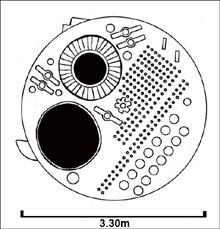 |
|
Diver�s measured sketch of the boiler face, showing diagnostic details helpful in identifying the vessel. (A Curdts/NOAA ONMS)
|
The most conspicuous features of the site are the boiler and engine, as both project above the surf. The boiler is a two-furnace riveted Scotch cylindrical marine boiler, with a 10’10” width and a 10’6” length. It has an attached cylindrical steam chamber, and a detached cylindrical vessel near the boiler face. One of the fire doors lies adjacent to the boiler face as well. The double compound steam engine has fallen onto its port side. Its two cylinder diameters (outside dimensions) are approximately 21” for the high pressure and 39” for the low pressure cylinders (inside dimensions encrusted and difficult to determine). The engine foundation is distinctly marked “United Engineering Works Builders SF CAL,” a critical clue to the identity of the vessel.
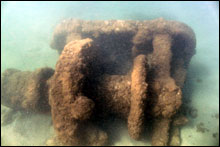 |
|
One of the submerged cargo winches on its side. (J Coney/NOAA ONMS)
|
The shaft from engine to screw propeller has a length of 26’3”, and the propeller is a four-bladed screw with a diameter of 9’ 10”. Near the engine lies a storage tank measuring 18’10” in length and 8’ 0” in width. A second similar tank lies submerged in shallow water approximately 200 hundred yards to the west. Two similar deck steam winches with 6’ wide bases (one upright, one on its side) lie closer the shore, and one twisted piece of large 2” diameter wire rope is nearby. Miscellaneous iron straps and unidentified metal debris make up the remaining material in the main wreck area.
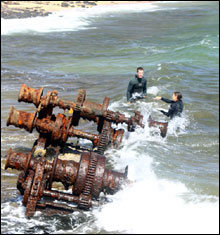 |
|
Team sketching the shore side windlass and winch. (J Coney/NOAA ONMS)
|
On the western side of the site, components are spread a little farther apart (see shoreline map). An unidentified piece of steam machinery lies 230 feet from shore, surrounding by an assortment of unidentified metal debris and two hawse pipes, one 10’10” long and the other 18’0” long. Breaking surf is fairly constant in this area, limiting the amount of detailed work possible. Inshore from these items, the iron upper sheer strake of the bow section with fairlead openings for mooring lines projects out of the water. Finally, on the rocky coastline itself, an iron steam winch and steam windlass rest in the intertidal surf. A gear on the steam winch is marked “United Engineering Works,” similar to the engine offshore. Two more hawse pipes are adjacent to these items, both 9’10” in length. Numerous small pieces of metal debris rest in the water near the shore features.
A great deal of wooden timbers possibly associated with this wreck lie in an extensive pile on the shoreline. Survey of these features, begun with the assistance of students from Lāna`i High & Elementary School, unfortunately was not completed during the 2009 season, and remains for a future project.
Wreck Site Interpretation
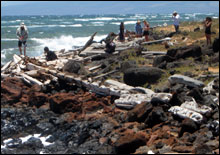 |
|
Students from O`ahu and Lāna`i documenting the frames, keelson and hull planking components on the shoreline. (H Van Tilburg/NOAA ONMS)
|
From the data collected during the 2009 Return to Shipwreck Beach project, preliminary conclusions can be made regarding the identification of this site. First of all, the site represents an intentional deposition. Shipwreck events often represent significant loss of property and sometimes loss of life. These accidents are usually covered in the local media if not on a broader scale as well. However, the intentional grounding of a worn-out vessel at the end of its useful service is not a major event, and usually not recorded by local sources. There are no records of any accidental steamship wreck for the island of Lāna`i. Furthermore, there is no physical evidence apparent at the site indicating accidental loss, i.e. anchors or anchor chains or any effort to save a vessel in distress.
Secondly, the shipwreck site represents a local wooden-hulled inter island steam vessel, its features being consistent with the design of these vessels, and the location compatible with the history of the area’s use as a graveyard for aging inter island ships. Judging from the distribution of features, the ship came to rest with its bow facing westward, and was then broken apart by wave action. But which local steam vessel is this? Without specific historical documents or positive evidence from the site (such as the ship’s name), we can only look to circumstantial evidence to make a possible identification.
- The relatively short propeller shaft indicates an engine (and therefore boiler and stack) placed further aft on a vessel, rather than amidships;
- The lack of extensive wire rope rigging and lack of mast and rigging hardware indicates partial dismantling prior to grounding;
- The site has four large winches/windlass, rather than the more usual two;
- Engine and deck machinery labeled United Engineering Works.
Working towards an Identification
The information from the site survey can now be compared to both the known list for steamship losses or disposals on Lāna`i (see Project History), and the list of Hawaiian inter island steamships not otherwise reported as wrecked or lost elsewhere, or transferred away from the islands. There were many of these inter island steamers in Hawai`i, but fortunately a smaller selection of the total can be made, namely those which match the size and design criteria as defined by the wreck site itself (in other words, only 100-plus ton double-compound wooden-hulled single-screw steamships). This select list includes the following vessels: Ni`ihau; Mikahala; Keauhou; Kilauea Hou; Ivy Holmes; Kaiulani; and Hawai`i. Combined with the single steamer known to have been abandoned on Lāna`i, Hornet, the list for possible candidates that match the 2009 survey site comes to eight vessels.
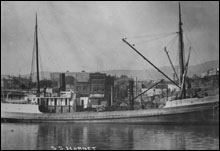 |
|
Exterior view of the SS Hornet located (most likely) pier side at San Pedro, California, prior to being altered for the Hawai`i cattle trade. (Allen Knight, Bishop Museum)
|
Of these eight ships, only one is specifically noted as having her engine constructed by United Engineering Works in San Francisco: the SS Hornet. The Hornet`s engine cylinder diameters fall within range of the site measurements. Her engine was situated aft, rather than amidships, consistent with the relatively short propeller shaft recorded at the site. And Mifflin Thomas, in Schooner from Windward, records that the Hornet was partially dismantled prior to being disposed on Lāna`i in December, 1927. Furthermore, Thomas states that a second pair of deck winches was added to the Hornet during alterations which would allow the ship to transport cattle. At one time, Lāna`i Ranch had 45,000 sheep and lambs, 600 horses, and 500 horned cattle, as well as goats and hogs. Ranching was a way of life for Lāna`i residents from the 1860’s to 1951. The Hornet was part of that ranching industry, a vital link in the history of the island.
The 176-foot long SS Hornet (697 gross tons, 307 net), built in Aberdeen Washington in 1906 by Lindstrom Shipbuilding Company,was already an 18-year old hardworking West Coast steamship when she was purchased by the Hawaiian Meat Company in 1924 and brought to the islands as a replacement for the SS Bee. The Bee had been in the cattle trade but on April 8th, 1924, struck a reef off Honomanu, Maui, and was a total loss. The Hornet, however, was only in service for two years before she was transferred to Inter Island Steam Navigation Company in June, 1926, and put into the lay-up fleet.
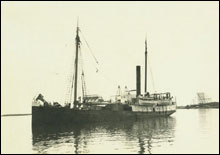 |
|
The local Inter Island steamer SS Kaiulani, owned at the end of her career by Amos Frank Cooke and Kurt A.M. Kahnert. Is the Kaiulani now somewhere at Shipwreck Beach? (Inter-Island Steam Navigation Company, Bishop Museum)
|
The identification of the wreck site with the SS Hornet, once thought to possibly be the wreck at Awalua, is based on circumstantial evidence, for ship owners did (infrequently) sometimes completely replace steam engines in vessels…and historical documentation for these ships remains incomplete. Steam engine specifications and boiler design for the wreck at Awalua appear to correspond to the description of the SS Mikahala. The 2009 survey is only the second investigation of an Inter Island Company steamship wreck site on Lāna`i’s north shore. Several more such surveys may be possible. Results, therefore, should be considered preliminary.
Significance of Steamship Wrecks: Hawai`i’s “Mosquito Fleet” and the Inter Island Steam Navigation Company
The history of inter island steamships links Hawai`i to developments on the national and international scale. Marine steam engines revolutionized the shipping industry on a global scale, and American-built steam vessels in Hawai`i dramatically changed the economic and social and political nature of the islands. This shipwreck site, therefore, is associated with the tools of change which impacted island society.
Steamship companies played an important role in the Kingdom of Hawai`i, even though steam navigation actually got off to a slow start. The first steamer to operate in local Hawaiian waters, the American twin-screw steamer Constitution arrived at Honolulu on January 24th, 1852…but the unwieldy vessel made only one round trip to Lahaina, before returning to the mainland. The following year the S.B. Wheeler (renamed Akamai), built in Maine, shipped in parts around Cape Horn and reassembled in Benicia California, arrived in the islands. The small side wheeler seemed unsuited to the rough channel passages, though, and was better employed as a tug for sailing ships at Honolulu from 1854 to 1857. The sparse trickle of small steamers to the islands continued, some formerly used in California servicing the Gold Rush communities. During the mid-19th century, local steamship operators entered the market, beginning with the Hawaiian Steam Navigation Company (incorporated in 1861), operating the well-known steamship Kilauea, which ran between the islands carrying freight and passengers from 1860 to 1878. This slow pace, however, all began to change following the signing of the Reciprocity Treaty in 1876 and the opening of markets on the U.S. mainland for Hawaiian agricultural products. The economic viability of large plantations meant an immediate need for inter island services.
In response to these increased needs, three local steamship companies soon emerged as corporations: Wilder Steamship Company (Samuel G. Wilder), Inter Island Steam Navigation Company (Thomas R. Foster), and Pacific Navigation Company (Amos F. Cooke). Pacific Navigation experienced costly setbacks due to a number of shipwrecks, and folded in 1888. The other two, Inter Island and Wilder, dominated the island scene, operating in friendly rivalry for more than two decades. Wilder Steamship Company serviced Maui and the windward ports on the island of Hawai`i, while the Inter Island Steam Navigation Company handled the island of Kaua`i and the Kona and Ka`u and the Hamakua ports on the Big Island. In 1905 the two companies were joined under one management, resulting in a single Inter Island Company fleet at that time of 14 steam vessels: Maunaloa, Ni`ihau, Mikahala, W.G. Hall, Iwalani, Keauhou, Noeau, Kinau, Claudine, Maui, Helene, Kaiulani, Likelike, and Lehua. The fleet was later enlarged by the purchase of the Hawai`i and Hornet from the Hawaiian Meat Packing Company in 1926. All of these hard working ships, familiar sights among all of the Hawaiian Islands, formed the backbone of inter island freight and passenger transportation.
Inter Island Steam Navigation Company vessels went into active wartime service immediately following December 7th, 1941. The corporation grew into a diversified overseas terminal, ship repair and hotel business (also spawning Inter Island Airways, which later became Hawaiian Airlines), but by 1950 the local Hawaiian steamship operation had become unprofitable and was discontinued. The surviving Inter Island vessels were either run aground, dismantled, or sold at auction and scattered around the world.
|

